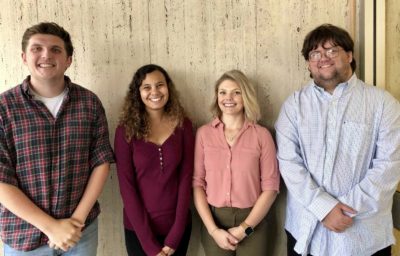Amplifying public history: Taking OAH beyond their annual meeting
04 December 2018 – Jackie Swihart, Garrett Receveur, Sam Opsahl and Stasia Tanzer

Pictured from left to right: Sam Opsahl, Stasia Tanzer, Jackie Swihart, Garrett Receveur. Photo credit: Christine Crosby
When we were approached by NCPH to work with the Mellon-funded “OAH Amplified Initiative,” we were excited to put skills learned from our graduate classes into practice and further NCPH’s mission to build community and expand historians’ professional toolkit.
The project was designed to make the Organization of American Historians’ annual meeting more accessible to members and to a larger public history community. NCPH saw the partnership as a way to engage the IU School of Liberal Arts’ History Department at IUPUI (where NCPH is headquartered) and its flagship Public History MA Program. As the graduate students involved in the project, we hope to explain the process by which we created the modules to serve as an example for future Amplified Initiative projects. We also aim to discuss the objectives of our work and its potential uses for public historians.
In April of this year, Jackie Swihart and Sam Opsahl attended the OAH 2018 Annual Meeting where they sat in on preselected sessions and conducted interviews with panelists. The sessions—selected by project advisors Jennifer Guiliano, Stephanie Rowe, and Rebecca Shrum—covered topics that were seen as most relevant and critical to the field of public history. Later, Stasia Tanzer and Garrett Receveur joined the group to help create the modules, and we began working as a full team in June 2018.
Our primary goal was to make the session audio and video recordings from the OAH conference more accessible to anyone who might utilize our modules. To do so, we divided and conquered: we identified three main themes and put each session into one of these categories. These categories became our modules. From there, we created finding aids to make these resources more easily navigable and pulled together books and articles mentioned by the panelists, as well as our own supplemental sources that seemed relevant.
Once we had a solid repository of information, we developed loosely-organized lesson plans for each session and module. Our idea was not to have a highly structured product, but a guide that could be modified by whoever wanted to use the material. For instance, the “Career Paths for Public Historians” module includes sources related to the various positions a student of history could apply for and helpful links to assist with writing resumes and cover letters. Each session is similarly equipped with sources related to particular career paths, such as exhibit development and documentary editing. The “Arming and Engaging Citizens” module highlights case studies that might be of use to practicing public historians interested in contemporary issues flanking our field. Sessions within this module include immigration, the status of Confederate monuments, and how best to engage children in museums. Lastly, the “Training Public Historians” module is tailored to faculty looking to prepare public history students to navigate issues related to gender and employment in the field, as well as the opportunities and challenges presented by the intersections of digital and public history.
We created these three distinct and navigable modules so that professors, students, and (public) historians alike may use them in whatever capacity they deem fit. They serve as an outlined resource for people who are interested in immersing themselves within the field of public history. The digital platforms allow any public historian in practice or training to join a community and reflect on historical practices. It is meant to serve as a stepping stone introduction to our field for some and a professional tool for others. We invite everyone to explore this free resource. We hope it will be a launching point for those discovering the field of public history for the first time, as well as a resource for those looking for a new way to teach and connect with others in the field.
~ Jackie Swihart is a second-year graduate student in the public history program at IUPUI. She was the project leader for the Amplified Initiative and worked on the module “Training Public Historians.” She currently interns at Indiana Humanities in Indianapolis.
~ Garrett Receveur is a second-year graduate student in the public history program at IUPUI. He worked on the module “Arming and Engaging Citizens” and currently interns at the James Whitcomb Riley Museum Home in Indianapolis.
~ Sam Opsahl is a second-year graduate student in the public history program at IUPUI. He worked on the module “Career Paths for Public Historians” with Stasia Tanzer and is currently interning at the National Council on Public History office in Indianapolis.
~ Stasia Tanzer is a second-year graduate student in the public history program at IUPUI. She worked on the module “Career Paths for Public Historians” with Sam Opsahl. She currently interns in the curatorial department at the Eiteljorg Museum of American Indians and Western Art in Indianapolis.



